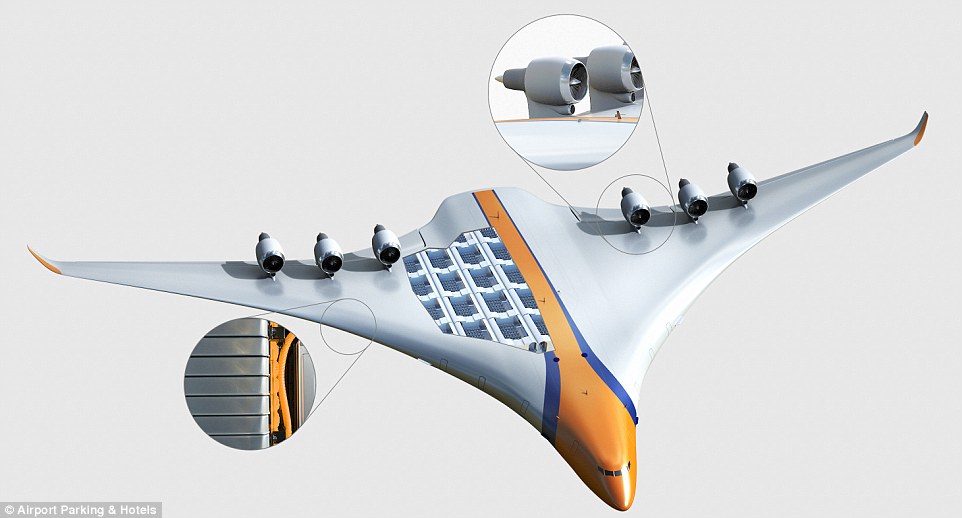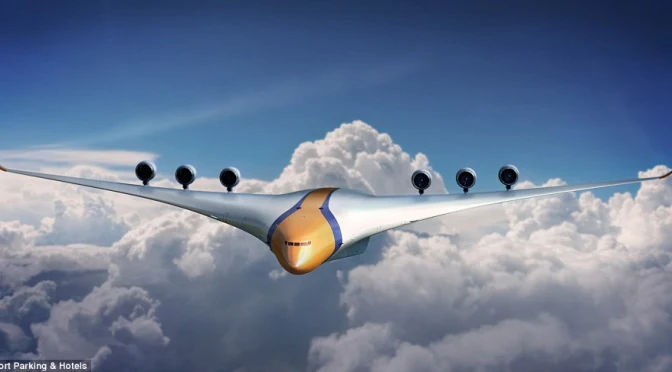The team from Airport Parking & Hotels and Imperial College London has brainchild and predicted a huge curved future concept aircraft which could realistically look like around 30 to 40 years from now.
This marvelous projected aircraft could be the way people travel to far-flung destinations in the year 2050.
With a comprehensive design inside and out, this incredible futuristic plane features tremendous 1,000 cabin seats, virtual reality headsets, live image projections on the walls instead of windows and spacious lounges intended to improve the passenger experience.
Airport Parking & Hotels and Imperial College London partnered to predict what the future of flight could realistically look like in 40 years.

A team, including aircraft design students, came up with a futuristic concept with cutting-edge technology (pictured: premium cabin).

A wider aircraft creates more cabin space, and the designers filled some of it with in-flight bars that allow passengers to socialize.

The design team from London said there would be a seating capacity for 1,000 passengers on the blended wing aircraft.

With a complete rethink, the team, including aircraft design PhD student Adam Omar, designed an advanced plane that bears some of the hallmarks of today’s jets and next-generation technology.
Thanks to its blended wing design, its fuselage would be wider and shorter and it wouldn’t have a tail wing, and it would be propelled by six bio-fuel engines at the back of the body.
The designers say the aircraft would have more legroom than today’s planes despite having so many people on board because of its widened body and large wings.
Of the notable changes, the concept plane has very few windows, which could make air-travel uneasy for some.

Backseat monitors would be replaced with wraparound virtual reality headsets built into the seats with wraparound visors that display 3D films and programs. The visors are designed to automatically fold away on takeoff and landing or in the event of an emergency.

In addition to improving passenger experience, the team aimed to design a plane that is fuel efficient and less harmful to the environment eliminating the reliance on fossil fuels.

The concept plane would run on low-emission bio-fuels and be propelled by clusters of electric fans powered by small engines.
Instead, transparent LCD screens on the walls display the view outside or films, programs or maps from the in-flight entertainment system, or relaxing scenes to help passengers fall asleep.
In-flight bars would allow passengers to get out of their seats and socialize more freely with other travelers.

The traditional airport design would have to be overhauled in order to accommodate the planes and allow passengers to board.

Designers said large portions of the seating, flooring and walls could be made from ultra-light metal micro-lattice developed by Boeing.

For their high-capacity aircraft, the designers took cues from futuristic concepts previously produced by Airbus, Boeing and NASA.

With electric fans powered by small engines, the plane would produce just a tiny fraction of the emissions from current aircrafts and reduce drag.

The plane would have very few windows, so transparent LCD screens would be installed on the interior walls to display outside scenes.
Beverley Barden, head of marketing at Airport Parking & Hotels, said: ‘Air travel has long been considered an uncomfortable way to begin a holiday.
‘With these advances in passenger space, in-flight-entertainment, and extra room for bars and relaxation areas, it will be a great revolution in the aviation industry.
Source: People’s Daily China and Dailymail.co.uk
